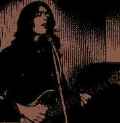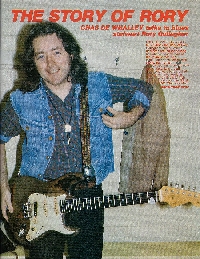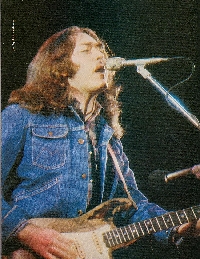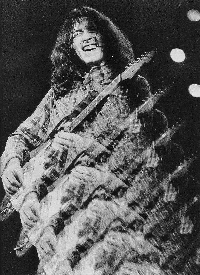|
Mailing & Discussion List  |
|
|
|
|
|
|
| Forward to next article |
 THE STORY OF RORY
THE STORY OF RORY “Nothing's original
on it now except the finish - and there's not much of that left
either! It's been re-fretted a few times and I've had lots of new
bridges and machine heads. The original electrics rusted out
years ago from all the sweat of gigging. I've tried putting all
sorts of different custom pick ups on it but I've always ended up
replacing them with standard factory Fenders because they just seem to
suit the guitar the best. What I have done which is quite an
innovation is rewire the circuit so that I've got one master tone
control and one master volume control, leaving the middle knob null and
void. It makes the Strat behave more like a Telecaster which
means I can use the tone control to create a wah wah effect on the lead
pick-up. You can't do that on a standard Strat.
“Nothing's original
on it now except the finish - and there's not much of that left
either! It's been re-fretted a few times and I've had lots of new
bridges and machine heads. The original electrics rusted out
years ago from all the sweat of gigging. I've tried putting all
sorts of different custom pick ups on it but I've always ended up
replacing them with standard factory Fenders because they just seem to
suit the guitar the best. What I have done which is quite an
innovation is rewire the circuit so that I've got one master tone
control and one master volume control, leaving the middle knob null and
void. It makes the Strat behave more like a Telecaster which
means I can use the tone control to create a wah wah effect on the lead
pick-up. You can't do that on a standard Strat. to ensure you get
the slide exactly on top of the fret, otherwise you'll sound
flat. You have to get the pressure of the slide against the
strings right too. It's surprising how many great guitar players
can't manage that properly. They press too hard and the strings
rattle and buzz too much. You have to be a bit like an ice
skater, but once you've got the knack then you never lose it. But
to be a really good slide player you have to use more than one finger
on your right hand. I know that sounds a little traditional and
maybe too folky or country for rock. But if you have the ability
to pick out chord figures and slide in and out of inversions then you
can really broaden your scope as a guitarist.
to ensure you get
the slide exactly on top of the fret, otherwise you'll sound
flat. You have to get the pressure of the slide against the
strings right too. It's surprising how many great guitar players
can't manage that properly. They press too hard and the strings
rattle and buzz too much. You have to be a bit like an ice
skater, but once you've got the knack then you never lose it. But
to be a really good slide player you have to use more than one finger
on your right hand. I know that sounds a little traditional and
maybe too folky or country for rock. But if you have the ability
to pick out chord figures and slide in and out of inversions then you
can really broaden your scope as a guitarist.|
Mailing & Discussion List  |
|
|
|
|
|
|
| Forward to next article |